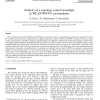Free Online Productivity Tools
i2Speak
i2Symbol
i2OCR
iTex2Img
iWeb2Print
iWeb2Shot
i2Type
iPdf2Split
iPdf2Merge
i2Bopomofo
i2Arabic
i2Style
i2Image
i2PDF
iLatex2Rtf
Sci2ools
COMCOM
2006
2006
Analysis of a topology control paradigm in WLAN/WPAN environments
The coordinated coexistence of WLANs and WPANs in a dual-mode network is a recently introduced idea and is expected to increase the overall system performance by allowing for the efficient cooperation of both WLANs and WPANs. Topology control (e.g., power control, smart antennas, and different frequency channels) needs to be employed to allow for the simultaneous operation of both modes. In this paper, different frequency channels that allow for high data rates within a small transmission range are considered in order to create multiple WPAN environments inside a WLAN cell. The latter environment requires the support of a second mode of operation which introduces additional overhead that may degrade the overall system performance. Certain conditions, under which system performance improvement is achievable, are established here. In particular, an analytical mobility model for WPAN environments is proposed and employed in the analytical studies. It is shown that the system may be effec...
| Added | 11 Dec 2010 |
| Updated | 11 Dec 2010 |
| Type | Journal |
| Year | 2006 |
| Where | COMCOM |
| Authors | Athanasios Vaios, Konstantinos Oikonomou, Ioannis Stavrakakis |
Comments (0)

